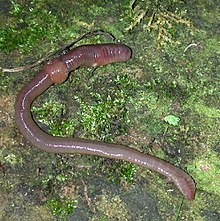
Back Wurm Afrikaans Cuco AN دودة Arabic ܬܘܠܥܐ ARC Viérbene AST Laq'u Aymara سولوجانلار AZB Селәүсен Bashkir Kėrmėns BAT-SMG Ulod BCL


Worms are many different distantly related bilateral animals that typically have a long cylindrical tube-like body, no limbs, and usually no eyes.
Worms vary in size from microscopic to over 1 metre (3.3 ft) in length for marine polychaete worms (bristle worms);[1] 6.7 metres (22 ft) for the African giant earthworm, Microchaetus rappi;[2] and 58 metres (190 ft) for the marine nemertean worm (bootlace worm), Lineus longissimus.[3] Various types of worm occupy a small variety of parasitic niches, living inside the bodies of other animals. Free-living worm species do not live on land but instead live in marine or freshwater environments or underground by burrowing.
In biology, "worm" refers to an obsolete taxon, Vermes, used by Carolus Linnaeus and Jean-Baptiste Lamarck for all non-arthropod invertebrate animals, now seen to be paraphyletic. The name stems from the Old English word wyrm. Most animals called "worms" are invertebrates, but the term is also used for the amphibian caecilians and the slowworm Anguis, a legless burrowing lizard. Invertebrate animals commonly called "worms" include annelids, nematodes, flatworms, nemerteans, chaetognaths, priapulids, and insect larvae such as grubs and maggots.
The term "helminth" is sometimes used to refer to parasitic worms. The term is more commonly used in medicine, and usually refers to roundworms and tapeworms.
- ^ "Cornwall – Nature – Superstar Worm". BBC. 7 April 2009.
- ^ "Worm Digest - The Mighty Worm". 2 October 2005. Archived from the original on 19 February 2009.;
- ^ Carwardine, Mark (1995). The Guinness book of animal records. Enfield: Guinness Publishing. p. 232. ISBN 978-0851126586.